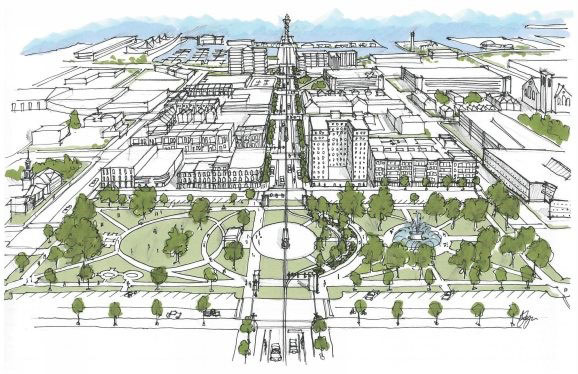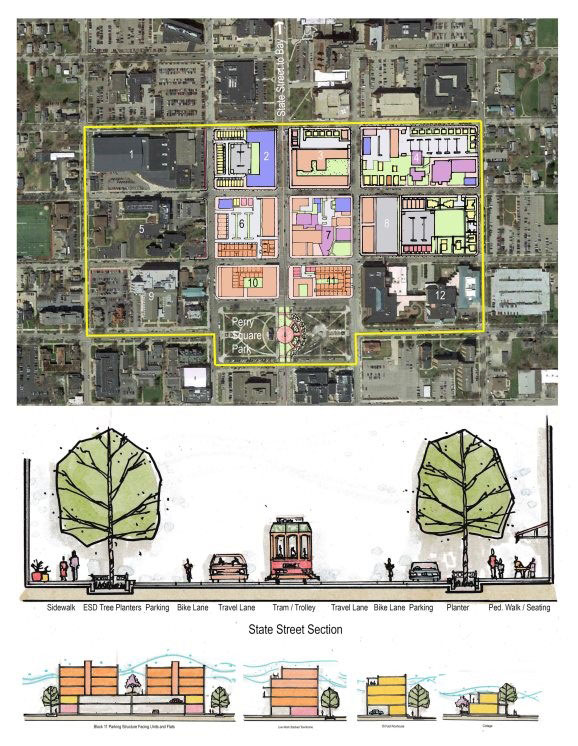Recently, I traveled to Erie, Pennsylvania, to serve as the community and urban designer on an Urban Land Institute (ULI) advisory panel convened to provide recommendations for Erie's downtown revitalization efforts.

Photo courtesy Andrew Lyons
A City in Need of Change
Erie has faced a number of challenges similar to other Rust Belt cities that were once the centers of manufacturing. In 2018, a 24/7 Wall Street report highlighted Erie as a city with significant employment and income as well as housing disparities among its different populations. Amid these severe problems and challenges, a remarkable change has begun to unfold. Erie residents, with the election of a new mayor, are starting to believe in their city again. Erie is reemerging in the 21st century, working to find its way in a post-industrial, post-manufacturing climate. Business leaders, government officials, and local residents are banding together to drive Erie's resurgence and approached the ULI for recommendations to help in positioning the city for the future.
Bringing Together the A-Team
The advisory panel was tasked with addressing six questions geared towards creating a guide for future revitalization of the city overall, as well as for a specific 12-block area downtown. These questions covered areas of concern, including economic development, harnessing resources for downtown business initiatives, growth and retention, how to locate and obtain funding, reprioritizing its land use of valued spaces, transportation and connectivity, and attracting new and retaining existing talent in Erie's downtown.
Other panelists who served included Richard Reynolds - chair (The Reynolds Group, Boston, MA), Nan Rohrer (Midtown Community Benefits District, Baltimore, MD), Walt Bialas (Jones Lang LaSalle, Dallas, TX), Lucia Garsys (Hillsborough County, Tampa, FL) Stanley Lowe (Neighborhood Preservation Services, Pittsburgh, PA), Tom Murphy (Senior Resident Fellow, ULI Washington, DC), and Steve Leeper (CEO, 3CDC, Cincinnati, OH). Drawing upon our individual areas of expertise, we ultimately developed recommendations as to what Erie could focus on in order to promote revitalization of the downtown and surrounding areas, as well as viable strategies for implementing a recovery and revitalization plan. Several key recommendations were produced as the result of an intense five-day process that involved site visits, interviewing stakeholders, conducting market analyses, reviewing local policies and data, design sketches and drawings, and identifying constraints and opportunities. As we narrowed our focus down to the important recommendations, a design framework for a revitalization plan began to take shape.
A Framework for Revitalization
Here is a summary of key recommendations:
- Strengthen the planning department to become the keeper of the future
- Create a mayor's task force to reimagine Erie
- Enhance financial capacity to do public-private partnerships
- Identify internal and external funding sources
- Rebuild Erie's neighborhoods
- Follow guiding principles for block redevelopment
- Increase residential units downtown
- Provide ground- floor commercial development on commercial corridors
- Right size the amount of parking downtown
- Increase the priority of complete streets and other critical streetscape improvements
- Create a cohesive "one street" with a strong connection between the downtown resources and districts, the bay waterfront, and to Presque Isle and Lake Erie
The final report will be published by the Urban Land Institute.

My sketches, which were included in the panel's final recommendations presentation to prominent members of the community and stakeholder staff, show our overall "one street" vision along with block-by-block redevelopment options and potential new housing possibilities.(Photo courtesy Daniel Anderton)